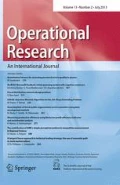Abstract:
This paper is part of a greater effort of the London Severe Injury Working Group that is aiming to the improvement of care, treatment and transfer of severely injured patients. The problem we address in this paper emanates from the Location Set Covering Problem literature. We sought to position the minimum number of trauma centers within a network of existing hospitals and minimize the total traveling time of patients, from the place of injury to the hospital of final treatment in such a way that everyone in the entire population of London can reach a trauma center within acceptable time limits. A mathematical programming approach has been adopted in order to solve the problem. The created model proved very useful in enlightening the problem and providing a set of solutions easily understandable by all parts involved in the final decision. The proposed configuration of the trauma centers was provided to the London Severe Injury Working Group for subsequent decisions.
Similar content being viewed by others
References
Anderson I.D., Woodford M., De Dombal F.T., Irving M. (1988). Retrospective study of 1000 deaths from injury in England and Wales. British Medical Journal 296:1305.
Bardi M., Mortagy A. and Alsayed A. (1998). A multi-objective model for locating fire stations. European Journal of Operations Research vol. 110, 243–260.
Baumol, W. and Wolfe, P. (1958), “A warehouse-location problem” Operations Research,6, pp. 252–263.
Berman O., Drezner Z. and Wesolowsky G.O. (2001). Location of facilities on a network with groups of demand points. IIE Transactions vol. 33(8), 637–648.
Branas Ch. and ReVelle Ch. (2001). An iterative switching heuristic to locate hospitals and helicopters. Socio-Economic Planning Sciences vol. 35, 11–30.
Brandeau M. and Larson R. (1986). Extending and applying the hypercube queing model to deploy ambulances in Boston. TIMS Studies in the Management Sciences vol. 22, 121–153.
Brimberg J., Juel H. and Schobel A. (2002). Linear Facility Location in Three Dimensions — Models and Solution Methods. Operations Research vol. 50(6), 1050–1057
Cronk J., Howell D., Saints K. and Krieger H.A. (1986). Positioning of emergency facilities in an obstructed traffic grid. Mathematical Modelling vol. 7(4), 611–626.
Eaton D., Daskin M., Simmons D., Bulloch B. and Jasma G. (1985). Determining emergency vehicle deployment in Austin Texas. Interfaces vol. 15, 96–108.
Francis, R. L., McGinnis L.F. and White J.A. (1992). Facility Layout and Location: an Analytical Approach. Prentice-Hall, Inc., Englewood Cliffs, NJ.
Galvao R. and ReVelle Ch. (1996). A Lagragean heuristic for the maximal covering location problem. European Journal of Operations Research vol. 88(1), 114–123.
Goodman A., Manbeck K., Ricks B. and Solow A.E. (1986). Emergency facilities location. Mathematical Modelling vol. 7(4), 603–610.
Hewitt R.L. (2002). Siting a fire station by leveraging soft constraints and supporting science. Interfaces vol. 32(4), 69–74.
Laporte G., Gourdin E. and Labbe M. (2000) The Uncapacitated Facility Location Problem with Client Matching, Operations Research vol. 48(5), 671–685.
Levin Y. and Ben-Israel A. (2004). A heuristic method for large-scale multi-facility location problems. Computers & Operations Research vol. 31, 257–272
London Severe Injury Working Group (2001). Modernizing Trauma Services in London. Report and Recommendations.
Marianov V. and ReVelle Ch. (1995). Siting Emergency Services in Facility Location: A Survey of Applications and Methods, (Drezner Z., Ed.). Springer-Verlag, New York, 199–223.
Melkote S. and Daskin M.S. (2001). Capacitated facility location/network design problems. European Journal of Operational Research vol. 129(3), 481–495.
Mirchandani, P. B., Francis R. L. (ed.). (1990). Discrete Location Theory. J.Wiley & Sons, New York.
Moore G.C. and ReVelle Ch. (1982). The hierarchical service location problem. Management Science vol. 28(7), 775–780.
ReVelle Ch. (1997). A Perspective on Location Science. Location Science, vol. 5(1), 3–13.
ReVelle, C. & Marianov, V. (1991). A probabilistic FLEET model with individual vehicle reliability requirements. European Journal of Operational Research vol. 53, 93–105.
Schilling D., Elzinga D.J., Cohon J., Church R. and ReVelle C. (1979). The Team/Fleet models for simultaneous facility and equipment siting. Transportation Science vol. 13(2), 163–175.
Toregas C., Swain R., ReVelle C. and Bergman L. (1971). The location of emergency service facilities. Operations Research vol. 19, 1363–1373.
Weber, A. (1909). Über den Standort der Industrien. Teil 1: Reine Theorie des Standorts, VerlagJ.C.B. Mohr, Tübingen, Germany.
Author information
Authors and Affiliations
Corresponding authors
Rights and permissions
About this article
Cite this article
Skintzi, G., Ioannou, G., Prastacos, G.P. et al. Modelling of facilities for head injuries in London. Oper Res Int J 3, 197–212 (2003). https://doi.org/10.1007/BF02936401
Issue Date:
DOI: https://doi.org/10.1007/BF02936401




